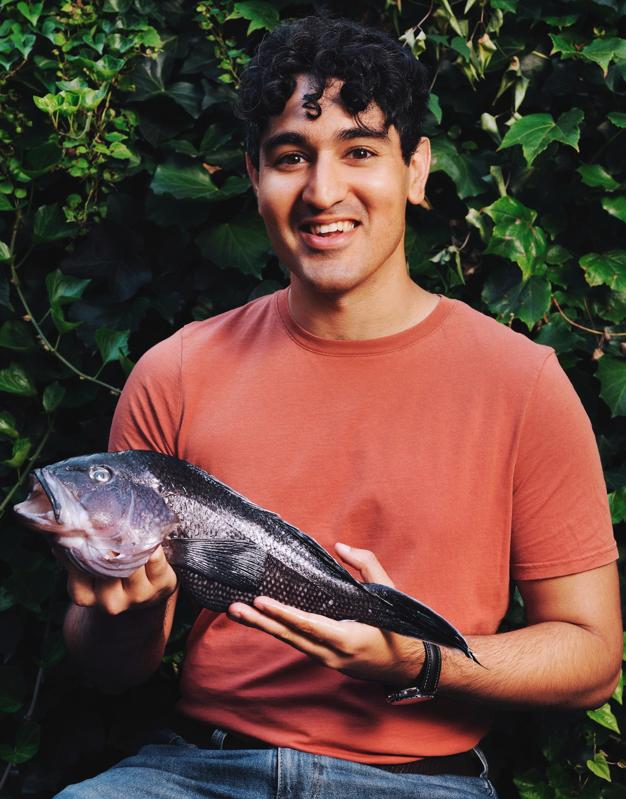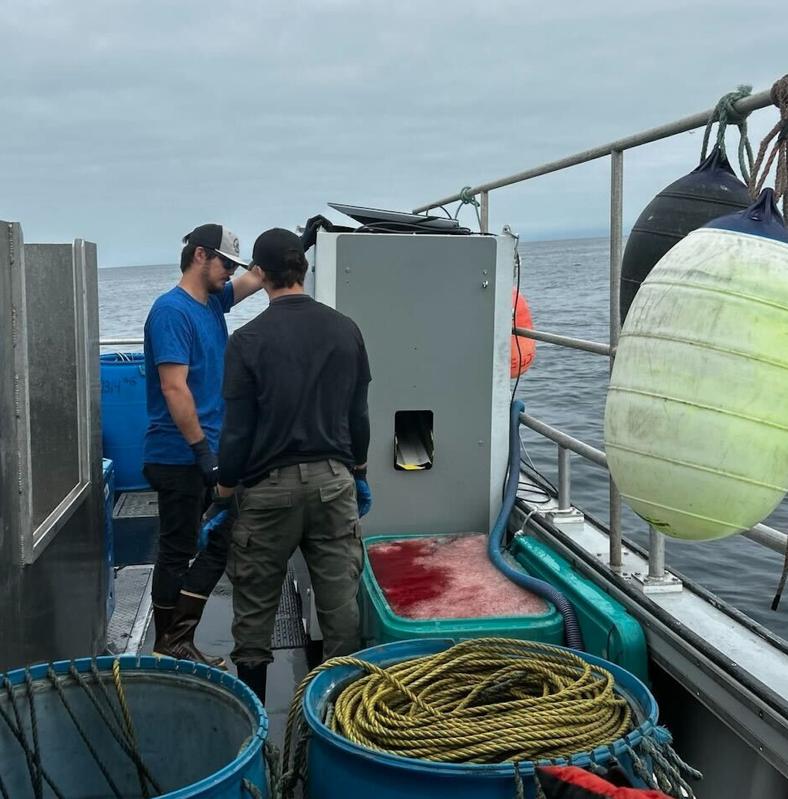When 25-year-old Saif Khawaja read the essay, If Fish Could Scream, his quarter-century of life seemed to come full circle. Growing up on different coasts around the world, Khawaja loved to fish with his father and grandfather. So the writing by Princeton University bioethics professor and animal rights philosopher Peter Singer, which depicts suffocating fish, struck a chord. On top of that, living in Saudi Arabia and the UAE with a strict halal diet, he has always respected the ritual of killing animals for human consumption in the most humane way possible.
Since then, Khawaja has been building a company that takes the ancient Japanese technique of humanely dispatching fish, called ike jime, and scaling it in a way that has not been done before: with AI-powered robotics. Under his umbrella company, Shinkei Systems, Khawaja has raised more than $7 million, leading to today’s launch of Seremoni, a reimagined supply chain of fish, the company tells me exclusively. Rather than ‘sushi-grade,’ the company labels the final product with the newly-trademarked term, ‘Seremoni-grade.’ “This is a food company just as much as it is a technology company,” Khawaja says. His primary objective with Seremoni is to “fuse technology to scale these artisanal systems in a way that unlocks [a new] level of nutrition.”
Seremoni Founder Saif Khawaja
Seremoni
Middle Eastern Food Standards Meet Japanese Techniques
Within a few months of immigrating to America to attend UPenn’s Wharton School of Business, Khawaja started feeling foggy and lethargic. “One of the first signals for me was that food tasted very bland,” he says. “I now look back and realize taste is a proxy for nutrition.” Halal, the standard grade for meat across much of the Middle East and South Asia which Khawaja was accustomed to, is typically regarded as higher quality than American factory-farmed meat. The realization of this drastic change sparked a desire for him to pursue a career in Western food systems.
He eventually earned a degree in economics with a concentration in innovation and design as well as a Master’s in physics. He came across a video in 2020 where Andrew Tsui, President of the Ike Jime Federation, demonstrated ike jime, the method of inserting a t-shaped spike into a fish’s head, which is considered more humane than letting it suffocate, thus increasing its quality, shelf-stability and market price. Khawaja wondered why no one had automated the process yet. “All food should be like this,” he thought. “Halal and kosher are the exact analogs to ike jime.” Fast forward a bit, and Tsui is now an advisor to Khawaja and a shareholder in Shinkei Systems.
“There’s money to be made in perishability,” Khawaja says. “In North America…we throw out more fish than we actually eat. About 45% of that is due to bycatch and spoilage.” By launching Seremoni today to sell a more esteemed grade of fish commercially, Khawaja is on his way to disrupt the conventional American fishing industry by proving that sustainability can also be fruitful.
Inventing Poseidon
Before he began creating a prototype of an automated ike jime machine, Khawaja would go out and speak with fishermen to understand their needs. “I basically got the middle finger everywhere,” he says about pitching East Coast fishermen his idea. On the West Coast, more were susceptible, so he packed his things, moved cross-country, and opened a 7,000 square foot warehouse in El Segundo, CA where he has since hired 15 employees.
Seremoni CTO Reed Ginsberg
Seremoni
One of them is Reed Ginsberg, a SpaceX alum, who is now Chief Technology Officer of Shinkei Systems. Ginsberg generated five pillars of creating the machine, which the team dubbed ‘Poseidon.’ The first is simply ‘inserting’ the fish into the side of the machine, where it’s then ‘constrained’ to locate the brain and gills using AI. “We’ve trained an algorithm to detect the brain so we don’t need any humans in the loop,” says Ginsberg. The company believes that this is a safer and more consistent practice than doing it by hand. A vision system then provides an ‘image’ of what’s happening inside of the machine so that the team can go back and collect data for future modifications.
The final two steps are ‘brain’ and ‘bleed.’ “The braining always has to happen first because you don’t want the fish to feel any pain or stress,” Ginsberg explains. “They’re brain dead effectively, but their hearts will still pump.” The machine will then cut the gill to pump out the blood to place the fish into rigor mortis, the state of stiffness. “If the fish flops around for an hour suffocating, it’s burning through all its energy…whereas what we do, fish is coming right out of the water and immediately it’s brain-spiked. All the energy is still in the fish.”
Automated Ike Jime Machine
Seremoni
Where the team has taken the technology even further is that Shinkei Systems installs a SpaceX Starlink dish on each of its automated machines. “Now any time we want to make over-the-air software updates, we can use the Starlink,” Ginsberg says. This also provides fishermen with WiFi on their boats.
Incentivizing Automated Ike Jime
The two species of fish Seremoni is launching with are black cod and black sea bass. “There’s so much amazing local fish that we don’t eat,” Khawaja says. “Black cod is a delicious fish, it just doesn’t have all the money and branding behind it [compared to fish like salmon or tuna].”
Seremoni incentivizes fishermen to catch these lesser-caught fish with its unique business model, starting with renting the machines to fishermen for free and paying them to use it. Seremoni then purchases the fish directly from the fishermen–typically $10 per pound. Ike jime makes these fish more valuable, so they’re making more money than they otherwise would by catching these fish. It’s also alleviating overfishing of the more popular fish and the fishermen don’t have to learn how to perform ike jime by hand, which is very laborious. “We want to eliminate the jobs that nobody wants while earning the fishermen more money so they can focus on other parts of their business,” Ginsberg says. Distributors (currently in Chicago, New York, San Francisco and Los Angeles) buy the fish from Seremoni.
In conjunction with the University of New Hampshire, Shinkei Systems conducted several studies that show its automated ike jime process produces improved fish quality in certain areas. The previously unreleased data, among other revelations, shows that the best 7-day pH for Seremoni-grade rainbow trout is higher than that of traditional ike jime and conventional fishing. Water retention was also found to be higher, which increases the weight and consequently raises the selling price for fishermen.
Americans Taste Seremoni-Grade Black Cod
Chef Junya Yamasaki of YESS in Downtown LA has taught a slew of Southern California fishermen the ike jime method and also happens to have been serving Seremoni’s black cod for the past month. While Yamasaki holds the belief that traditional ike jime can be safe and consistent, he is particularly impressed with the entire cycle of Seremoni’s process. “Their method of catching black cod is very good…trap fishing, not line-caught,” he says. Fish stress much less with trap fishing, which increases the quality even further, the chef explains, mimicking the ike koshe method of placing fish in a tank in between catching and killing to recuperate energy.
Seremoni-Grade Fish
Seremoni
If you’ve been able to get your hands on ike jime fish in America, it all but certainly would be at an upscale Japanese or seafood restaurant. Where Seremoni is really taking the concept to a place it’s never been is by selling it in retail. The first store to carry Seremoni is Happier Grocery in New York City. “The introduction of new things is something that we really love doing with our customers, so there was brand alignment there already,” says Alexandra Hamile, Head of Marketing & Strategy at Happier Grocery. “When Saif took us through how fishermen fish now versus how he’s doing it with Seremoni, it just made a lot of sense for us to take a chance on him.” The increased shelf-stability without having to freeze Seremoni’s fish makes it ideal for retail.
Happier Grocery sells Seremoni’s two varieties in a vacuum sealed package for between $26.99 and $28 for two filets. “Everybody couldn’t stop talking about the fish,” Hamile says. “We’re excited about the momentum that we’ve had so far and hopefully we’ll be able to incorporate more species at some point.” The difference in taste and texture is most noticeable when you eat the cod or sea bass raw as nigiri or sashimi.
The elephant in the room is that Shinkei Systems is not following ike jime with shinke jime, the process of thrusting a long wire into the ike jime hole to cease the fish’s nervous system, which is another factor that can increase quality. The startup says it’s working on prototypes to elevate its technology to incorporate shinke jime into a future version of the machine.
Khawaja’s vision is intentional and laser-focused. “My hope is that one day we can design Seremoni to run as a co-op with fishermen,” he says. He is determined to improve issues unique to the American food system with practicality based on data that he and his team obsessively collect. “I’ve lived in a lot of different places, and America has been the most welcoming place to be,” he says. “This is American fish caught by American fishermen, handled by American suppliers, sold to American consumers to feed Americans.”




